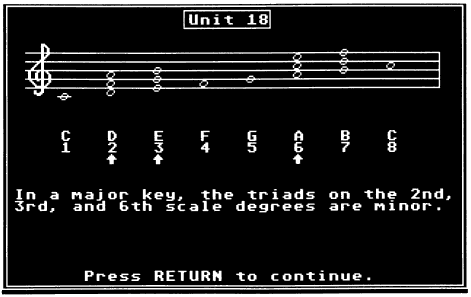INTERACTIVE MUSIC EDUCATION
Two Teaching Programs Have Plenty To Offer
Both Amateurs and Pros
BY LARRY A. MAGNELLO
Educational applications are a growing field for the Atari ST. This is particularly true in the music field, where developers can capitalize on the ST's inherent ease of use, graphics capabilities and built-in MIDI ports. One such developer is the Alfred Publishing Comany, which sells the Practical Music Theory course and its associated Music Achievement Series. Author Sandy Feldstein offers a course for the absolute beginner who has never read music before. It can be used for home study or as part of a music classroom.
What You Get
Practical Music Theory is a six-disk, self-instructional, music-theory
course, covering the basics from drawing a staff through composing simple
melodies. The Music Achievement Series package is a flexible test series
on three program disks, designed to evaluate knowledge of music fundamentals.
The packages come with instruction manuals, review worksheets, manuscript
paper and answers (to guarantee proper learning, even without a teacher).

A typical lesson screen
from the Practical Music Theory music-education package.
For this review, I ran Practical Music Theory and the Music Achievement Series on a 520 ST, a 1040 ST. a Mega 2 and a Mega 4. The software runs in low, medium, and high resolution. You have the option of using a MIDI instrument or just the internal monitor speaker. Display graphics appear in low resolution regardless of what monitor you use. The color monitor is more pleasant to the eyes, rather than looking at black background on the high resolution monitor.
Practical Music Theory
The Practical Music Theory course offers 84 lessons divided into three
parts. Introductory lessons cover the bass and treble clef staffs, notes,
timing, ties, slurs, repeat signs, flats, sharps, and major and minor scales.
After learning these basics, you are led into more complex musical concepts
such as a circle of fifths, chromatic scales, dynamics, triplets, syncopation,
major and minor chords, dominant seventh chords, triads, and tempo markings.
The last section focuses on harmonizing a melody, composing a melody, transpositions,
inversions, harmonics, melodic minor, and augmented and diminished chords.
Three review sections reinforce what you have learned.
|
|
|
| Product
Type: Company: Price: Requirements: Summary: |
Practical Music Theory and
Music Achievement Series Music education Alfred Publishing Co.
PMT, $299.95: MAS. $199.95 512K, any rez Easy to use and
|
Music Achievement Series
The Music Achievement Series is the first comprehensive publication
of computerized tests in music. It is particularly useful for music educators
in a classroom setting. With these tests you can assess new students' music
ability levels, evaluate music-program objectives, guide student learning
and study skills, and evaluate pre-test or post-test scores of students.
The Atari ST speeds the collection and analysis of test scores, actually
storing each student's score as they complete a test. Teachers can easily
review student scores and get computer printouts of the test scores.
Each time one or more students take these tests, the computer generates a new series of items in each section. The computer randomizes the testing program so that each student or group of students has a new and unique set of questions, enhanced by computer graphics. The testing procedure assists the teacher to focus on areas of specific need.
There are three levels of tests or quizzes within the Music Achievement Series, each covering specific lessons such as notation, rhythms, terms, scales and chords. Starting with level 1, you are tested on the basic elements of music theory. Level 2 moves into the areas of major key signatures, symbols and intervals. The final level is for those serious about their musical studies. Included here are the chords, major triads, V7 chords, transposition of music keys, minor scales and harmonizing bass notes of chords.
Teacher's Evaluation
As a composer, arranger and music teacher, I feel the Practical Music
Theory package offers an excellent course for the individual that has never
had any music training, as well as for musicians that play by ear and want
to learn to read and write music. My only concern is when the program asks
you to identify high and low pitches of musical notes. The pitch sounds
are played before the program asks you the question "Is the pitch higher
or lower?" After a few questions of this sort you catch on that the high
and low pitch sounds will be played before you begin to answer the question.
The manuals in the two packages are well done, but in the Music Achievement Series testing manual the ink used in the printing is not dark enough. Overall the documentation is clear and concise and written with both the amateur and professional in mind. The amateur will find this program an easy introduction to music education, while the professional will not feel restricted by it.
This is the first appearance in START of composer arranger, music teacher and ST enthusiast Larry Magnello.